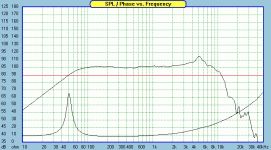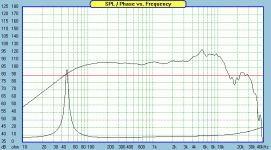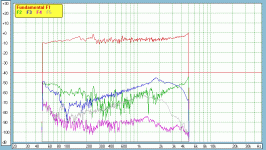That mindset cuts across all cultures, I assure you. I have many friends, relatives, work colleagues, neighbors, of all different cultures and ethnicities who make a hobby/sport out of bargain hunting and minimizing cost/benefit ratio on everything they buy.Maybe it's a cultural thing, but for me it's a sport to minimize the price as much as possible when I know I can get the same performance.
Can always use that money for something else or another project
I will search out a bargain when buying a car, or having a big renovation on the house... but I don't seek out bargains when buying eggs, or bread, or a box of screws, or a pair of scissors... My time has value also... 🙂
It's not always about the bargain, but just about optimizing as well.I will search out a bargain when buying a car, or having a big renovation on the house... but I don't seek out bargains when buying eggs, or bread, or a box of screws, or a pair of scissors... My time has value also... 🙂
But yeah, I get what you mean 🙂
Yes I do. Let me start by saying I know nearly nothing about the mixing/monitoring process... @krivium is a good source of information on that.This is one that I may want to build. Jim, do you think that this project would be good as a midfield monitor for mix/ playback/comparison usage?
Since DSP is in the signal chain, the spectral balance can be tailored for a given listening position in a given room. The basic architecture will have a lot of flexibility, and it should be possible to integrate different midrange/tweeters, including a waveguide option if that is what you want. The passive crossover needs to manage the magnitude and phase through the crossover region, and suppress the midrange cone breakup resonance. But all of the baffle step, bass EQ, spectral balance, in-band resonance suppression, and voicing is handled by DSP.
In a professional application (revenue generating), one would have to consider upgrading the electronics. I would probably recommend the MiniDSP Flex, and a higher quality 2 channel amp, rather than the low-cost equipment I am planning to use.
j.
Bottom line is that one has only money and time to spend on getting something done. And how much value you your time.That mindset cuts across all cultures, I assure you. I have many friends, relatives, work colleagues, neighbors, of all different cultures and ethnicities who make a hobby/sport out of bargain hunting and minimizing cost/benefit ratio on everything they buy.
I will search out a bargain when buying a car, or having a big renovation on the house... but I don't seek out bargains when buying eggs, or bread, or a box of screws, or a pair of scissors... My time has value also... 🙂
ust sharing details of a 3-way project from the past that used a similar Dayton woofer in a similar-sized cabinet:
https://www.humblehomemadehifi.com/download/Humble Homemade Hifi_Black Box.pdf
One of the consequences of me staying out of DIY speaker activity for 20 years is that I am unaware of much of what happened between 1998 - 2018... unaware of the "who" "what" and "when"... I almost designed this exact same speaker, but using a different tweeter. The Dayton D52AN seems like a great dome midrange for the price.
The spacing guidelines are a good place to start the simulation or prototype process. They seem to work very well in LR2 and LR4. If the baffle around the tweeter is kept very small, the CTC spacing becomes less important. The 3rd order crossovers seem to be less influenced by the CTC spacing. The path difference between the tweeter and the mid (acoustical offset, or z distance) plays a role, and sometimes the quasi 3rd order LR3 works well.I think this rule of thumb pertains to an acoustic LR4 crossover. I’m not sure how valid it is for other crossovers.
I always take the risk of building a pair of cabinets based on simulations with ideal piston drivers. When the cabinets are done, I make measurements of the drivers installed. This is a risk, and there is always a possibility I will find that a different CTC spacing or a different roundover/bevel is needed. In that case, I would have to build a new pair of cabinets. I try to do the baseline in-cabinet measurements before I have applied expensive veneer or spent time in finishing... I have never needed to scrap a pair of cabinets, but that is always a risk for me. The low risk approach would be to make a prototype cabinet first.
j.
I like the flexibility, and I've got all the amps that I need, both AB and D. I've used dsp powered pa mains, subs, and monitors for years now, and finally got my first pair of dsp powered mix monitors, and they've all been a huge revelation of adaptability. I am new to mixing, so I just want to get to being the best that I can be, for myself, and the bands and musicians that I know and play with. GlennYes I do. Let me start by saying I know nearly nothing about the mixing/monitoring process... @krivium is a good source of information on that.
Since DSP is in the signal chain, the spectral balance can be tailored for a given listening position in a given room. The basic architecture will have a lot of flexibility, and it should be possible to integrate different midrange/tweeters, including a waveguide option if that is what you want. The passive crossover needs to manage the magnitude and phase through the crossover region, and suppress the midrange cone breakup resonance. But all of the baffle step, bass EQ, spectral balance, in-band resonance suppression, and voicing is handled by DSP.
In a professional application (revenue generating), one would have to consider upgrading the electronics. I would probably recommend the MiniDSP Flex, and a higher quality 2 channel amp, rather than the low-cost equipment I am planning to use.
j.
Last edited:
When the time comes for this part of construction, I will take lots of photos and explain how I cut the tapered bevels.Cutting tapered bezels intimidates me every time, it is pretty much the the last machining step and the chances of turning an enclosure into another pile of scrap is a very real possibility.
j.
Here is a (german) description how to do it manually, which allows to stop any time for checking.Cutting tapered bezels intimidates me
the pictures (scroll down) are probably enough to understand donhighend's method:
https://www.donhighend.de/?page_id=1441
Anyone seen any medium to high quality
measurements of this KRK Rokit 10-3 G4 speaker?
Not sure 4” is required here……higher efficiency and higher power handling from a 3” driver like the Faital Pro 3fe22 will get this job done and save some $$$. Given the high priority of overall tone and timbre from a mid in a 3 way, I’d encourage you to try a couple and just voice them…….throw em on a baffle with a rear chamber and just listen all by themselves
I suggest the Faital pro again from a point of subjectivity and what we know we don’t know…..that pincushion dust cap presents a fwd lobe that sounds like it’s coming from behind the enclosure…..very nice.
Wanna go bigger?……for $80, I think you’d be hard pressed to surpass the Aurum Cantus AC130…..another really fantastic sounding driver with a timbre that screams organic analog in its harmonic distortion presentation. Truncated frame would still work on your baffle
I suggest the Faital pro again from a point of subjectivity and what we know we don’t know…..that pincushion dust cap presents a fwd lobe that sounds like it’s coming from behind the enclosure…..very nice.
Wanna go bigger?……for $80, I think you’d be hard pressed to surpass the Aurum Cantus AC130…..another really fantastic sounding driver with a timbre that screams organic analog in its harmonic distortion presentation. Truncated frame would still work on your baffle
Last edited:
That is an excellent technique for cutting bevels.Here is a (german) description how to do it manually, which allows to stop any time for checking.
the pictures (scroll down) are probably enough to understand donhighend's method:
I've searched all kinds of reviews for many studio monitors, and found nothing but subjective reviews with zero measurements. GlennAnyone seen any medium to high quality
measurements of this KRK Rokit 10-3 G4 speaker?
At this point I am 90% decided on using the SB15NBAC30-4 as the mid driver. For the price, I have not found anything else that equals its combination of smooth frequency response, low distortion, and clean CSD/ step response performance.
Dayton 10" RS270-4 $131
SB15NBAC30-4 $82
SB29SDAC $52
Total $265
So I am within 6% of my original driver budget, even though I changed the requirement from an 8" woofer to a 10" woofer.
Thank you to everyone for all the excellent advice and information on driver selection.
This is the current concept sketch, showing the size/position of the midrange enclosure.

Dayton 10" RS270-4 $131
SB15NBAC30-4 $82
SB29SDAC $52
Total $265
So I am within 6% of my original driver budget, even though I changed the requirement from an 8" woofer to a 10" woofer.
Thank you to everyone for all the excellent advice and information on driver selection.
This is the current concept sketch, showing the size/position of the midrange enclosure.
G3 here https://www.soundandrecording.de/equipment/studiomonitor-krk-rp-10−3-im-test/Anyone seen any medium to high quality
measurements of this KRK Rokit 10-3 G4 speaker?
I think not everyone would have the same definition of "compact" as well as "low cost" 😀 😀
Good set of drivers nevertheless, with a 5 inch I would only go for a waveguide again.
It's not really possible to meet the two without a slight bump in directivity otherwise.
Good set of drivers nevertheless, with a 5 inch I would only go for a waveguide again.
It's not really possible to meet the two without a slight bump in directivity otherwise.
Jim, will you be machining the frame of the RS270-4? From your drawing and my calculations the frame will overhand the 1/2 inch chamfers on the sides. I made this mistake on my most recent build, but that was because I screwed up and cut the chamfer on the bottom edge of the enclosure. I just lived with it, but you can just make your enclosure a little wider.
The sketch might be misleading... those dashed lines on the side of the cabinet show the internal cabinet wall, not the chamfering. The tapered bevels end well above the woofer.From your drawing and my calculations the frame will overhand the 1/2 inch chamfers on the sides.
That is certain... Cost and size is relative.I think not everyone would have the same definition of "compact" as well as "low cost"
- Home
- Loudspeakers
- Multi-Way
- Compact, low cost, active 3-way speaker



